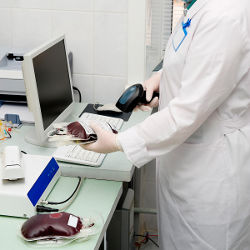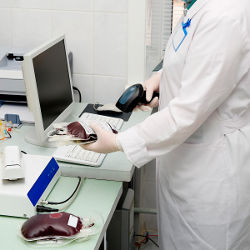
U.S. healthcare has made huge investments in health information technologies (IT). The U.S. Health Information Technology for Economic and Clinical Health (HITECH) Act of 2009 earmarked more than $20 billion to foster electronic health records (EHRs) at U.S. hospitals and other medical facilities, and facilities have spent billions of their own to digitize patient records and clinical workflows. What benefits have accrued? Have EHRs lowered the cost and improved the quality of healthcare? In particular, what has been the effect of EHRs on patient safety?
There is some evidence that EHRs reduce costs over the long term and under the right conditions.2,a But evidence is scant on the effect of EHRs on patient safety. An Institute of Medicine (IOM) 2012 study, Health IT and Patient Safety, concluded, "current literature is inconclusive about the overall impact of health IT on patient safety." This lack of evidence prompted an econometric study of patient safety at Pennsylvania (PA) hospitals. Patient safety improved for Pennsylvania hospitals that adopted EHRs: a 27% decline in overall patient safety events and a 30% decline in medication errors.b
What Is Patient Safety?
Patient safety can be described as "freedom, as far as possible, from harm, or risk of harm, caused by medical management (as opposed to harm caused by the natural course of the patient’s original illness or condition)."4 A patient safety event (PSE) occurs if a patient is harmed or unnecessarily placed at risk of harm. Every year PSEs affect hundreds of thousands of patients in the U.S. and cost billions of dollars.
Medical errors and the harm they cause have been seen as unavoidable side effects of modern medicine or the result of incompetence. Lucian Leape says, "many errors are preventable and many are evidence of system flaws not character flaws."7 The patient safety movement was brought to the medical mainstream by a report of the Institute of Medicine To Err is Human,5 with the goal to eliminate preventable patient harm through improved systems and find solutions to previously "unpreventable" errors.13
It is difficult to distinguish between known and acceptable risks and risks due to medical mismanagement. Concerns for patient privacy add to this problem. Finally, medical providers see PSEs on their watch as stains on their professional competence and may be hesitant to report them. Measuring PSEs is difficult. A popular approach is to use algorithms from the Agency for Healthcare and Research and Quality (AHRQ) to infer patient safety indicators (PSIs) from billing data. But these are viewed skeptically by the medical community. Peter Pronovost, a prominent Johns Hopkins physician, called them, "truly, near worthless," during a U.S. Senate hearing on patient safety.12
It is difficult to distinguish between known and acceptable risks and risks due to medical mismanagement.
AHRQ algorithms for PSIs can generate false positives if medical conditions deemed markers for PSIs were present on admission, if there were coding errors, or if the coding lacks specificity.9 Coding is notoriously inconsistent across hospitals, or even within hospitals. Global trigger tools (GTTs), a set of defined rules applied in retrospect to identify trigger events that help trained analysts identify PSEs, are also viewed with skepticism. Their large random sample makes them a superior measure of PSEs, but they are difficult to use due to high costs in their manual review process. Of course, PSEs can be measured through voluntary or mandatory reporting, but this has its own problems related to underreporting.
The medical community has experimented with many interventions to reduce patient safety events: harm reduction initiatives, training programs, and checklist use programs (to reduce surgical errors). The latter provides a good example. The World Health Organization (WHO) asserts, "in medicine, as in aviation, checklists can help ensure consistency and completeness in carrying out complex tasks," has encouraged surgical checklists, and has been working on other checklists for medical care.14 However, the impact of these interventions is not always clear. A study published in the New England of Journal of Medicine (NEJM) found no significant reductions in PSEs in a random sample of North Carolina hospitals, even though these hospitals had implemented patient safety initiatives.6 Another NEJM published study found no relationship between reduced operative mortality and surgical safety checklists, although prior studies had found beneficial effects.11 Showing clear benefits to patient safety from interventions has been difficult.
EHRs and Patient Safety
Our econometric study of EHRs and patient safety attempted to get around the measurement difficulties by using data from a mandatory patient safety reporting system. The Pennsylvania legislature mandated all PA hospitals to report patient safety events to the Patient Safety Authority, a PA state agency created by the "Medical Care Availability and Reduction of Error (MCARE) Act." MCARE encourages more accurate reporting by guaranteeing that PSE data is confidential, reducing provider and hospital concerns about malpractice lawsuits or loss of reputation. Providers and hospitals are less concerned about malpractice lawsuits or loss of reputation. Such confidentiality might seem unfair to consumers, but providers and hospitals are unlikely to disclose PSE otherwise and the data creates opportunities for learning and quality improvement that can benefit consumers and that otherwise might not occur.
Electronic health records are healthcare applications that digitize patient records and clinical workflows. EHRs might consist of a Clinical Data Repository (CDR) that stores patient data, a Clinical Decision Support System (CDSS) that assists providers by providing reference information and suggestions for care, a Computerized Provider Order Entry (CPOE) that enable providers to electronically place orders, and a Physician Documentation (PD) system that consolidates clinical notes across hospital departments. Errors in modern medicine occur because of work complexity, knowledge intensiveness, and the variety and volatility of circumstances.10 Tools that reduce these problems might reduce medical errors. Well-designed EHRs might improve patient safety by improving communications, making knowledge accessible, providing decision support, requiring key pieces of information for correct treatment, assisting with calculations, performing real-time checks, and assisting with monitoring.1
To give an example, an elderly patient with multiple chronic diseases and taking several medications might benefit from a well-designed EHR (for example, with a reconciled medication list for the patient) when treated for new medical conditions. The EHR can provide a physician with real-time access to the patient’s data, notes from previous encounters, drug-drug interaction alerts and drug-disease interaction alerts. These might influence the physician when ordering new medications, or the hospital pharmacist to infer the correct route of administration when following physician notes to fill the prescription. Hospitals with well-designed EHRs might improve safety for such patients.
The medical community has experimented with many interventions to reduce patient safety events.
One can imagine an ideal empirical test for whether EHRs affect PSEs. It would involve a randomized control trial (RCT) in which a randomly chosen subset of hospitals would adopt and use EHRs while those in a control group would not, so systematic differences in PSEs might be attributed to adopting or not adopting EHRs. Because such an experiment is completely unfeasible and too costly to perform, we adopted the next best approach using observational data. Given that adoption of EHRs in U.S. hospitals occurred over time, we exploited within-hospital variation and controlled for time trends to estimate the effect of EHR on PSEs. This difference-in-difference research approach has been successfully employed to estimate the impact of EHRs on PSEs.
In our study, approximately 30% of the PA hospitals had adopted advanced EHRs in 2005, with adoption growing to approximately 70% by 2012.c We found hospitals that adopted EHRs experienced a 27% decline in overall PSEs, with a 30% decline in medication PSEs. We think these results are significant, and they have been seen in other studies. Parente and McCullogh found a small beneficial effect of EHRs on three specific PSIs (infections, postoperative hemorrhage, and postoperative pulmonary embolism).8 Freedman et al. found beneficial impact of CPOE on four postoperative PSIs that may be amenable to decision support.3 These two studies have results directionally similar to ours. EHR adoption and concomitant work flow changes can lead to patient harm but those problems do not challenge the potential value of EHRs in reducing PSEs. EHRs should not contribute to medical errors, but on average, EHRs seem to be improving patient safety.




Join the Discussion (0)
Become a Member or Sign In to Post a Comment